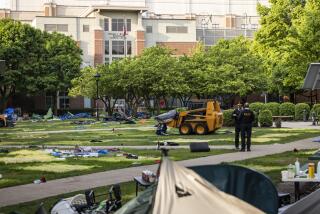Campus Correspondence : Separate by Choice: Racial Segregation at Duke
- Share via
We call this place the Gothic Wonderland, and by all appearances that’s what Duke University is. With its ornate architecture, manicured lawns and clear North Car olina skies, it’s hard to imagine a more beautiful place to go to college. But behind the grand facade is a racially divided school.
Duke is part of the growing trend toward, maybe even the leader of, segregated campuses. Most white students aren’t even aware of the gap at Duke. Whites live on the west campus, the hub of the university, surrounded by the accouterments of money and power--and plenty of beer on the weekends. Blacks tend to live in central-campus apartments, some distance from the alcohol-dominated social scene and much less expensive. Thus, the mainstay of segregation at Duke is the same as in every big city in the nation: housing patterns.
I’m from the suburbs of Chicago, and it’s perfectly natural to me that whites and blacks should live apart like this. I spent three years barely noticing thatDuke’s racial lines existed. The black experience here is radically different. There are about 500 African-Americans out of more than 6,000 undergraduates. By sheer numbers, blacks feel overwhelmed. In a classroom of 100 white kids, the two or three black students naturally will stick together.
It’s no surprise that the black students form an impenetrable alliance against the sea of white faces that surrounds them. I am told that black students walk the campus every day with the burden of proving that they are good enough to be here. To maintain their pride and integrity, African-American students develop a strong sense of commitment to each other. Whites feel excluded from that community, and the rift between the races grows.
But the problems are even more complex. For instance, blacks live apart on central campus because, I am told, they tend not to drink alcohol. A black student recently told me why: there is a subtle but powerful image in American culture that labels blacks who drink as lower class, possibly criminal, but almost certainly poor. A drunk white student, on the other hand, is perceived as a rowdy college kid having a good time. Alcohol, then, becomes a social wedge slicing between blacks and whites at Duke--and elsewhere, I suspect.
So I live in a dorm with other white students and, like so many others, I do not make any effort to contact black students. who generally live in their own sequestered area. It is the path of least resistance. I don’t think they want me around, and they think I don’t want them. We live with this undercurrent of tension until once in a while, some event drags everyone to the racial battle lines. Last week, for instance, a black student “removed” several hundred copies of the ultraconservative Duke Review from the student union, saying that he was throwing them away because they contained lies about the black student government on campus. While I am not a fan of the Duke Review, I was sent into rage over this unbelievable disregard for freedom of speech and of the press. Throw out newspapers because you don’t like the content? I was dumbfounded. I reeled from the idea that students at one of the best universities in the nation could forsake the principles of free discourse on which this nation was built.
There is no simple answer to the racial tensions on this campus, because we simply mirror the problems of the culture around us. Nothing will change on this campus until blacks and whites want to live together and share their college experiences. Certainly, we need a larger black student population here, and we need to change the housing patterns. But until we have the guts and the desire to cross racial barriers and care about each other, blacks and whites on this campus will continue to develop separate cultures and live in separate worlds.
More to Read
Sign up for Essential California
The most important California stories and recommendations in your inbox every morning.
You may occasionally receive promotional content from the Los Angeles Times.













